
The Hunger Games: Songs from District 12 and Beyond
20 May 2012 Leave a comment
in Database Entry, LIBR 265 Tags: music
 Burnett, T. Bone (producer). (2012) The Hunger Games: Songs from District 12 and Beyond. New York, NY: Universal Republic Records.
Burnett, T. Bone (producer). (2012) The Hunger Games: Songs from District 12 and Beyond. New York, NY: Universal Republic Records.
Summary:
The 15 songs on The Hunger Games movie soundtrack do not come from the film itself, although three are played during the credits, rather they are all original songs inspired by the movie and recorded by a diverse group of artists.
Critical Evaluation:
It’s tempting to dismiss this soundtrack as merely being a marketing gimmick, since it’s hardly a proper soundtrack. Actually listening to the songs does not give that impression. The goal was to make money, obviously, but the songs stay true to the themes and mood of the movie and make me think more of author’s writing playlists or creations from talented fans. Some, like Miranda Lambert’s Run Daddy Run sound much like the kind of folk music that might be sung in District 12, while more modern rock songs like Kid Cudi’s The Ruler and the Killer capture the anger and despair of the games themselves. And I must guiltily confess to tearing up more than once while listening to Taylor Swift, whose Safe and Sound deliberately evokes both Peeta’s injury and Rue’s final moments. The Hunger Games soundtrack may have initially made waves because of it’s ties to the popular movie and series, but it is the songs themselves, haunting and true to the spirit of the story, that continue to make this a popular album.
Reader’s Annotation:
15 haunting and original songs inspired by the girl who was on fire.
Author Information:
http://hungergamesmovie.org/category/hunger-games-soundtrack/
Genre:
music
Booktalking Ideas:
NA (although quite a bit of them would work as poetry to be read aloud)
Reading Level/Target Age:
NA/13-24
Possible Controversy:
For popular music, it’s very mild, especially considering the topic.
Reasons for Choosing This Title:
Friends kept talking about how great this was, and I found it strange at first that this film would have a soundtrack.
The Hunger Games
20 May 2012 Leave a comment
in Database Entry, LIBR 265 Tags: movie, politics, science fiction, survival
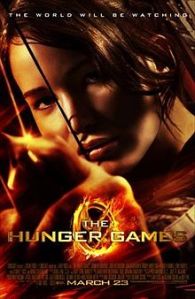 Jacobson, Nina (producer) and Ross, Gary (director). (2012) The Hunger Games [motion picture]. USA: Lionsgate.
Jacobson, Nina (producer) and Ross, Gary (director). (2012) The Hunger Games [motion picture]. USA: Lionsgate.
Plot Summary:
Film adaptation of the popular book series.
Critical Evaluation:
Creating a blockbuster film out of a novel that takes on reality tv, the commodification of violence, and consumerism, while staying true to these themes, is no small feat. For the most part, Ross and Jacobson have managed to accomplish this seemingly impossible task.
As in the book, the actual games takes up only a fraction of the of the film; the first two acts of the movie follow Katniss’ journey from Reaping Day in the Seam to training and appearances at the Capitol – and only then finally do we arrive at the games themselves. While it makes the film longer, those small moments, not just in Flickerman’s chair but backstage as well, are essential in turning the film into commentary like the book, rather than becoming the thing it is discussing. The lead up to the games makes it clear that this is a show that Katniss is participating in and that we are watching the creation of the show, not the show itself.
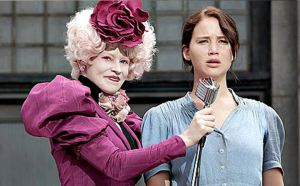 There are a few missteps (the shaky cam needs to die a horrible death and the mutts just don’t look real compared to the other dangers the teens have faced) but overall, the casting is brilliant (Lawrence, of course, but Harrelson, Stenberg, Tucci, and Kravitz as well all completely capture their character’s presence and purpose), the score is perfect (understated and haunting), and the ending is disturbing and thoughtful, not triumphant.
There are a few missteps (the shaky cam needs to die a horrible death and the mutts just don’t look real compared to the other dangers the teens have faced) but overall, the casting is brilliant (Lawrence, of course, but Harrelson, Stenberg, Tucci, and Kravitz as well all completely capture their character’s presence and purpose), the score is perfect (understated and haunting), and the ending is disturbing and thoughtful, not triumphant.
It’s going to be tempting for many reviewers and pundits to dismiss this film and those forthcoming as merely another Twilight, albeit perhaps a more “boy friendly” one. I’d like to encourage anyone thinking this to go to a midnight showing when Catching Fire comes out. If the experience is anything like when I saw The Hunger Games at midnight, what they will learn is that this series is connecting to teens in extremely profound ways and that they are not treating it as yet another movie. The theater I was in was almost deathly quiet from the moment the Lionsgate logo appeared. Call phones disappeared and the slightest sound was immediately shushed (aside from a few moments of laughter, surprise, and elation). There was a tremendous amount of reverence in the air; it was clear that the silence was not just to make sure that everyone could hear, but more importantly in order to show respect to the character’s experiences and deaths – even the careers – and steadfast a refusal to allow the film to be transformed into that which it critiqued by their own applause.
Reader’s Annotation:
May the odds be ever in your favor.
Author Information:
http://www.thehungergamesmovie.com/
Genre:
movie
Booktalking Ideas:
NA
Possible Reasons for Controversy:
Many parents find it too violent and the dark subject matter will be even more inescapable and devastating on screen.
While it may, in fact, be more violent than some younger teens should see, I would like to note that, among some of my teen patrons, it seems as though their parents’ opposition to them seeing the film is part of an organized effort rather than simply an individual decision. I don’t mean to say that this is not a grassroots movement or even that it is anything as established as that, more that the similar language I am hearing suggests not individual decisions based on private research; but that the parents are getting their information about the movie from the same or similar sources. I think this is important to be aware of because, since the movie has increased public knowledge of the book series, challenges to the books have increased. Not only is this likely to spill over into inclusion of the movie when it comes out on dvd, but also that challenges to one will possibly prompt challenges to each other – so the arrival of the movie in libraries may prompt challenges to the book.
Rather than simply taking each challenge on as it comes, it may be useful to identify if there are any organized groups opposing the series and create a more comprehensive rebuttal.
Reasons for Choosing This Title:
I loved the books; I had to see the movie.
Zombies Vs. Unicorns
19 May 2012 Leave a comment
in Database Entry, LIBR 265 Tags: anthology, fantasy, science fiction
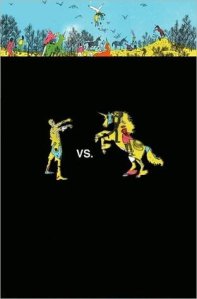 Black, Holly & Larbelestier, Justine. ed. (2010) Zombies Vs. Unicorns. New York, NY: Margaret K. McElderry Books
Black, Holly & Larbelestier, Justine. ed. (2010) Zombies Vs. Unicorns. New York, NY: Margaret K. McElderry Books
Plot Summary:
It all started when Larbelestier made an offhand comment on her blog about not endorsing unicorns. Black challenged her on it, Larbelestier responded in praise of zombies, and thus did an internet war begin. To settle this feud, Black and Larbelestier have each edited six stories written by twelve different authors and presented this in the same volume so that you, the reader, can make up your own mind.
Critical Evaluation:
Like most anthologies, Zombies Vs. Unicorns can be a bit uneven and but also wonderfully eclectic. Highlights include Maureen Johnson’s laugh out loud zombie tale The Children of the Revolution, Carrie Ryan’s poetic tale of destruction in Bougainvillea, Naomi Novik’s irreverent critique of innocence in The Purity Test, and Diana Peterfreund’s The Care and Keeping of Your Killer Baby Unicorn, which had me squeeling “HOW DID I NOT KNOW UNTIL NOW THAT THERE IS A FANTASY SERIES ABOUT TEEN GIRLS THAT HUNT KILLER UNICORNS!!!!!”
In addition to twelve zombie-or-unicorn packed stories, this collection also comes complete with hilarious commentary by our two illustrious editors. The back and forth between Holly and Justine regarding which is most awesomeist: zombies or unicorns was the perfect addition to this anthology. My only complaint was that their nerd!snark introductions got a little more spoilery than I would prefer, so if you tend to avoid spoilers like a zombie-borne-plague (or rainbow-colored-unicorn-farts?), I would suggest leaving the commentary until after you have finished the stories.
Reader’s Annotation:
Forget cavemen versus astronauts, the real question is “zombies or unicorns?”
Author Information:
http://blackholly.livejournal.com/
@hollyblack
http://justinelarbalestier.com/blog/
@JustineLavaworm
Genre:
Anthology
Booktalking Ideas:
I would totally divide the class up and get them debating zombies vs. unicorns, and add in trivia based on the anthology to get them even more interested.
Reading Level/Target Age:
6th grade/14-24
(Yeah, I know that’s rather old at the higher end, but the super glossy and pretty cover is clearly trying to attract an older audience in addition to the regular teens.)
Possible Controversy:
There is so much in this book for people to get nervous about – sex with unicorns being just the start. I suspect it will mostly get overlooked though because it’s fanbase, cover art, and premise suggest something a bit less…disturbing and sillier than what is inside. I think people also have an easier time ignoring single stories in anthologies than they do entire novels or anthology topics.
Reasons for Choosing This Title:
I am a nerd and I love teen books. There was no way I was not reading this. I have, in fact, made it my mission to get my copy signed by every writer that participated in it.
Karma
18 May 2012 Leave a comment
in Database Entry, LIBR 265 Tags: historical fiction, romance, war
 Ostlere, Cathy. (2011) Karma. New York, NY: Razorbill
Ostlere, Cathy. (2011) Karma. New York, NY: Razorbill
Plot Summary/Critical Evaluation:
I am skipping ahead to the evaluation so that I can say that no one should recommend this book ever. I’m not saying it should be banned or burned or anything, I just really think everyone’s time would be better spent on a novel that wasn’t so obnoxiously appropriative.
The genesis of the story alone is disturbing, not to mention how much it’s mentioned in the fore and afterwords. Ostlere was on an extended tour of various parts of the world when she found herself in India during the destruction and death that followed Indira Ghandi’s assassination. As she puts it: “My short-lived love affair with India was over.” It is unclear whether the author was simply referring to having to go home, or if the actions of those days caused her to fall out of love with the country. Unfortunately, the way in which she describes many of the people in India in the book – as superstitious and dismissive of the carnage that happens in their own country – suggests the latter rather than the former.
The story that Ostlere gives us is not all bad, nor is it full of nothing but racist caricatures. Almost everyone in the book is Indian – by parentage if nothing else, such as in the case of the main character Maya/Jiva. That’s what makes it so insidious; whether it was intentional or no, the racism is subtle and all the much more effective because of that. Maya’s story is fairly compelling…until we get to the point where Maya gets caught up in the events of 1984 just as the author did. Suddenly the shame and heartbreak of an entire nation is all about how it affects Maya. Despite the fact that her home still waits for her, unchanged. (Or, at least, as unchanged as it was when she left it.)
It would be bad enough if Ostlere had simply tried to tell two stories instead of one – the suicide of Maya’s mother and the subsequent fallout being the story that the novel begins with. Instead, Ostlere does not merely try to fit into that elegant tale another story about complex historical events and their effects on bystanders, she does so in a way that only lets us see these complexities through the eyes of someone that is a stranger to the land. It’s not just bad writing, it’s incredibly disrespectful.
Reader’s Annotation:
Maya, barely coping with the loss of her mother, is caught up in political riots while returning her mother’s ashes to her homeland.
OR
White Canadian writes about her experiences in India through the voice of a fictional Canadian girl whose parents are Indian immigrants.
Author Information:
http://cathy-ostlere.com/author/
Genre:
Multicultural
Booktalking Ideas:
Unless the booktalk is about what not to read? Nope, not doing it. Ever.
Reading Level/Target Age:
4th grade/13-17
Possible Controversy:
You mean, other than the subtle racism? There’s violence, of course, but nothing that stands out compared to other books.
Reasons for Choosing This Book:
It sounded interesting. And I was looking for a book about that part of the world, or kids whose families come from there, because there are a decent number where I live and work.
Midnighters: The Secret Hour
16 May 2012 Leave a comment
in Database Entry, LIBR 265 Tags: adventure, fantasy, mystery, science fiction, technology
 Westerfeld, Scott. (2004) Midnighters: The Secret Hour. New York, NY: HarperCollins Children’s Books
Westerfeld, Scott. (2004) Midnighters: The Secret Hour. New York, NY: HarperCollins Children’s Books
Plot Summary:
Jessica Day has just moved Bixby, a small town in the great state of Oklahoma. She isn’t sure quite what she was expecting, but it certainly didn’t include waking up at midnight one night to find the rain that had been pouring a moment ago suspended in the air as if time had stopped. Jessica quickly learns that most everything else spends the secret hour frozen in place; the only people or creatures that are ever awake during it are herself and a handful of her classmates at Bixby High. Well, and the Darklings, who exist only during the secret hour and seem especially determined to hunt down Jessica. Luckily Jessica and her new friends, Dess, Rex, Melissa, and Jonathon have some very unusual but sometimes useful superpowers.
Critical Evaluation:
Westerfeld’s plot concepts are are always crack for the imagination, and his execution here isn’t half bad either. There’s nothing about this story that doesn’t sound odd when laid out and summarized, but on the page it’s exciting and magical rather than absurd. Neither is everything perfect either, the teens superpowers come with a high price and their friendships are complicated and full of baggage. It’s fairly complicated for a young adult novelabout superheros, but it never lets this get in the way of having fun.
Reader’s Annotation:
She isn’t sure quite what she was expecting from Bixby, OK but it certainly didn’t include waking up at midnight one night to find the rain suspended in the air as if time had stopped.
Author Information:
http://scottwesterfeld.com/forum/
@scottwesterfeld
One of the great things about Scott Westerfeld’s site is that he doesn’t just encourage fans to engage with him, he encourages them to interact with each other and with his books; not only does his site include a forum but his blog will regularly feature fan art and creations.
Genre:
Action Series
Booktalking Ideas:
I love recomending this book to library patrons and will usually talk up either the Secret Hour, the Darklings, or the superpowers. For a booktalk I would try to touch on all three.
Reading Level/Target Age:
6th grade/14-17
Possible Controversy:
There might be some people who have religious objections to the premise – especially the presence of the Darklings. Other than that it’s unlikely to be challenged.
Reasons for Choosing This Title:
Once I read the premise – after noticing the book’s cover – I was totally drawn in.
Hatchet
15 May 2012 Leave a comment
in Database Entry, LIBR 265 Tags: adventure, survival
 Paulsen, Gary. (1987) Hatchet. New York, NY: Simon Pulse.
Paulsen, Gary. (1987) Hatchet. New York, NY: Simon Pulse.
Plot Summary:
Brian is on his way to visit his father after his parent’s divorce when the pilot if the two seater plane he is taking to get there dies of a heart attack mid-flight. Brian survives the crash, but the pilot does not, leaving Brian alone to survive in the wilderness, hundreds of miles from civilization.
Critical Evaluation:
Hatchet’s widespread appeal comes from the believability of Brian Robeson’s situation, and how he reacts to it. Despite being unlikely, none of the events in the book is outside the realm of possibility. When events first begin to unfold, Brian panics, as any thirteen year old would. He continues to make mistakes throughout his ordeal, but he also learns from them and always gets back up – eventually, anyway – once he’s been knocked down. Watching Brian constantly learning and problem solving keeps reader’s guessing “what if?” long past the initial hook of the story. The credulity of his saga, as well as the betrayal that led to his being on the plane in the first place, bring a emotional immediacy to Hatchet that is missing from mamy other survival scenarios.
Reader’s Annotation:
The sole survivor of a plane crash, Brian must find a way to survive in the wilderness, hundreds of miles from civilization.
Author Information:
http://www.randomhouse.com/features/garypaulsen/
Genre:
Adventure
Booktalking Ideas:
What would you do if the pilot of your flight had a heart attack at seven thousand feet? Could you fly the plane if there was no one else there? Would you live through the inevitable plane crash? How would you survive if you crashed hundreds of miles from civilization, with nothing but the clothes on your back….and your brand new hatchet?
Reading Level/Target Age:
5th grade/ 10-15
Reasons for Choosing This Title:
This book has been a mainstay when I do reader’s advisory for years, based on reputation and reader reviews. I figured it was time I actually read it myself.
The Princess Diaries
14 May 2012 Leave a comment
in Database Entry, LIBR 265 Tags: fantasy, friendship, humor, realistic fiction, romance
 Cabot, Meg. (2000) The Princess Diaries. New York, NY: HarperCollins Publishers
Cabot, Meg. (2000) The Princess Diaries. New York, NY: HarperCollins Publishers
Plot Summary:
Mia is an ordinary girl who spends her days doing ordinary things – like stressing out over math tests and getting caught up in her friend Lilly’s latest scheme. Until her dad comes to visit and confesses that he is actually royalty – and she, Mia Thermopolis, is the crown princess of Genovia. Being a modern princess is not all it’s cracked up to be though, and Mia is not at all sure she’s ready for the attention and responsibility. With help from her friends and family – and the best stylists money can buy – Mia finally find a way to be herself and save Genovia too.
Critical Evaluation:
Anyone who has simply seen the movie is really missing out. Cabot’s style is unique and hilarious, making this lighthearted story not only a breezy read but an absolute delight. Who cares how improbable it all is? As long as Cabot is snarking and cracking jokes, I’m there.
Reader’s Annotation:
Mia is an ordinary girl who spends her days doing ordinary things – until her dad comes to visit and confesses that she, Mia Thermopolis, is actually the crown princess of Genovia.
Author Information:
http://www.facebook.com/megcabot
@MegCabot
Genre:
Girl’s Series
Booktalking Ideas:
The hard part with this book is getting people to forget the style of the movie, while there are similarities, that’s not going top convince people that haven’t already to read the book. Pulling out some of the funny lines and jokes and letting them get a taste of that would be best.
Reading Level/Target Age:
6th grade/13-16
Potential Controversy:
This book is so full of fluff it practically floats. I would seriously wonder about anyone who challenged it.
Reason for Choosing This Book:
I, like many, dismissed this series as merely being as good as the movie so why bother? – until a cousin of mine began raving about them to me.
Stop Pretending: What Happened When My Sister Went Crazy
14 May 2012 Leave a comment
in Database Entry, LIBR 265 Tags: disability, family, grief, mental illness
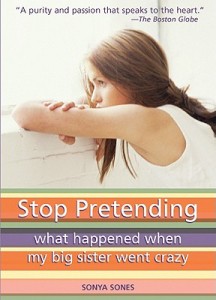 Sones, Sonya. (1999) Stop Pretending: What Happened When My Big Sister Went Crazy. New York, NY: HarperCollins
Sones, Sonya. (1999) Stop Pretending: What Happened When My Big Sister Went Crazy. New York, NY: HarperCollins
Plot Summary:
When Cookie’s sister suffers from a mental breakdown and is sent to a hospital to recover, Cookie deals with her confusion, pain, and loss the way so many other 13 year olds do – by writing poems. Starting from the night of her sister’s breakdown and ending with signs of recovery, Cookie chronicles the heartbreak and confusion of a family torn apart by mental illness.
Critical Evaluation:
Stop Pretending is the kind of story that is meant to be told in verse, for poetry is exactly the kind of creative outlet that a teen girl would turn to in an effort to deal with and make sense of the heartache of losing her sister to madness. While each poem helps to move the story along, every single one could also stand alone and feels like it would be the kind of poem a teen would write. (Readers will be unsurprised to learn that the story and poems are based on Sones’ own family’s experiences.) None of the verse feels forced or warped in an effort to include important plot points. Stop Pretending is crushingly beautiful and, like all good young adult books, ends on a sad but hopeful note that offers solace and understanding.
Reader’s Annotation:
When Cookie’s sister suffers from a mental breakdown and is sent to a hospital to recover, Cookie deals with her confusion, pain, and loss the way so many other 13 year olds do – by writing poems.
Author Information:
http://www.facebook.com/pages/Sonya-Sones/175441839174257
@SonyaSones
Genre:
Realistic Fiction
Booktalking Ideas:
Because the format is such a large part of the story, it would be important to incorporate into the booktalk use of the poetry.
Potential Controversy:
While some of Sones other books are often challenged because of their sexual content, Stop Pretending seems to mostly fly under the radar. There is frank discussions of mental illness and the typical teen angst and anger at her parents and sister.
Reasons for Choosing This Title:
I have to admit I picked this up in part because I thought it would merely be a quick read. I was pleasantly surprised by how good it was.
Crank
13 May 2012 Leave a comment
in Database Entry, LIBR 265 Tags: drug abuse, realistic fiction
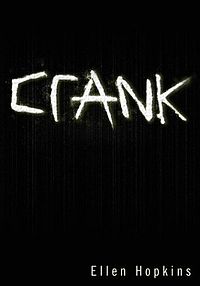 Hopkins, Ellen. (2004) Crank. New York, NY: Simon Pulse.
Hopkins, Ellen. (2004) Crank. New York, NY: Simon Pulse.
Plot Summary:
When Kristina leaves home to try to reconnect with her absentee father, she first stumbles across love…and then meth. Eventually Kristina has to go home and leave the boy behind, but the addiction stays with her. Kristina tries to it together and keep her secrets hidden, but piece by piece her formerly perfect life begins falling to pieces.
Critical Evaluation:
Hopkins’ poetry is not perfect by any means, but the disjointed free verse works well for the story being told, often mirroring Kristina/Bree’s fractured sense of self and loss of control. The story itself is compelling – when it sticks to Kristina’s interactions with her peers. Unfortunately, I could not get past the part where Hopkins is writing about a story similar to that of her daughter’s real life experiences – and doing so in the first person. It’s a disturbing example of co-opting another person’s experiences for your own needs and, considering that the person in question is a minor that was under your care at the time, rather silencing as well. I’m sure Hopkins feels as though she is giving a voice where one is needed, but her skewed focus is readily apparent during the times when Kristina contemplates her relationship with her mother. In general, the dynamic leaves me questioning the entire narrative.
Reader’s Annotation:
When Kristina leaves home to try to reconnect with her absentee father, she first stumbles across love…and then meth.
Author Information:
http://ellenhopkins.com/YoungAdult/
http://www.facebook.com/ellenhopkinsya
@ellenhopkinsya
Genre:
Realistic fiction
Booktalking Ideas:
The only time I would booktalk this book was if I was given a choice between it an Go Ask Alice. I will provide it to teens that ask for it and books like it, and ensure its place in my collection, but I will not tell kids to go read it.
Reading Level/Target Age:
6th grade/14-19
Potential Controversy:
Crank is frequently challenged because it includes drug use, profanity, sex, rape, violence, and illegal activities. Despite my misgivings about this book in particular, I believe these are all topics that should be available for teens to read about. Hopkins is clearly trying to warn kids off of drug use in particular, however, and that should help bolster the freedom to read arguments.
Reasons for Choosing This Title:
This is such a popular title among teens that I would feel remiss if I did not eventually get around to at least trying it.